A contactor is a switching device, widely used for the switching of motors, capacitors (for power factor correction), and lights. As the name indicates it is used to make or break contacts like an ordinary on-off switch. The only difference is that the contactors have an electromagnet that holds the contacts when energized whereas switches do not have it.
Their basic principle of operation is the same as that of electromechanical relays, the difference being, contactors are designed to can carry much more current than relays. Relays cannot be directly used in circuits where the current exceeds 20 amperes. Whereas contactors are available in a wide range of ratings and forms. Also, they are available up to the ampere rating of 12500A. They cannot provide short-circuit protection but can only make or break contacts when excited.
Constructional features
A contactor consists of an electromagnet, a set of power contacts, and a spring enclosed inside an enclosure. Some of them have built-in economizers, that can reduce power consumption in their coils. Certain arrangements for arc extinction are also made inside for making and breaking the operation.
Electromagnet Coil
An electromagnet is a key component without which contactors cannot function. It requires an additional supply for excitation. It drains negligible current from the supply during excitation. These electromagnets will be hollow and cylindrical in shape. A rod (armature) with a spring return arrangement will be placed in the hollow cylindrical electromagnet.
In some contactors, this electromagnet is split into two halves. One of the halves is fixed and the other is movable. Movable power contacts are fixed to the movable electromagnet. Under normal conditions, these two halves of electromagnets are held apart using a spring in between.
Different types of electromagnetic core arrangements in contactors are shown above. In those with AC coils, the electromagnetic core is made up of laminated soft iron to reduce eddy current losses and in those with DC coils, the electromagnetic core is made up of solid steel/ soft ironic core since there is no risk of eddy current loss in DC.
Contacts
A typical contactor consists of two sets of contacts, of which one is stationary and the other is moveable. Silver tin oxide (AgSnO2), silver nickel (AgNi) and silver cadmium oxide (AgCdO) are the normally used contact materials. These materials have high welding resistance and stable arc resistance. Contacts made of silver cadmium oxide and silver nickel are used in contactors of less ampere rating whereas contacts made of silver tin oxide are used in those of high ampere rating and in DC contactors.
The movable set of contacts is attached to the armature or movable electromagnet. Contact material must withstand mechanical stresses, arcs, and erosion and must have very low resistance.
Enclosure
Electromagnet and contacts are packed inside an enclosure made of plastic, ceramic, or Bakelite, which protects it from dust and the external environment and ensures the safe opening and closing of contacts.
Arc Suppressor
Arc extinction is one of the key functionalities of a contactor. AC arcs can be easily extinguished since it passes through zero twice for every cycle. Hence arc suppressors can do the job. But in the case of DC arcs, magnetic blowouts or specially designed arc chutes for arc extinction are necessary. Depending on the application, various arc suppression arrangements are made in contactors out of which arc chutes are one of them.
Economizer circuit
An economizer circuit is one used to reduce the power consumed by the coil. An economizer circuit supplies a high current during pickup and later it supplies adequate power to keep the contacts closed. It is not mandatory that all of them must have an economizer circuit.
Symbol of contactor
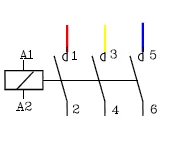
In the above picture, A1 and A2 are terminals for the control power supply or coil supply. Terminals 1-2, 3-4, and 5-6 are for the power supply. The load is connected to power supply terminals.
Working principle of contactors
Whenever the electromagnetic coil is energized, an electromagnetic field is produced. This electromagnetic field attracts the metallic rod (armature) toward the gap in the hollow cylindrical magnet.
In contractors with split electromagnets, the movable half of the electromagnet is attracted toward the fixed electromagnet. This action closes the contacts. The contacts remain closed as long as the electromagnet remains excited. When the coil is de-energized, moving contact is pushed back to its normal position by the spring. The contacts are kept spring-loaded in order to open and close contacts rapidly. Moving contacts may bounce as it rapidly makes contacts with fixed contacts. Twin or bifurcated contacts can be used to avoid bouncing and improve reliability.
The excitation power to the coil can be either AC or DC (available in various voltage ranges starting from 12Vac/ 12Vdc to 690Vac) or even universal. The universal coils are the ones that can operate on AC as well as DC voltages. A small amount of power is drained by the coil during the switching operations. Economizer circuits are used to reduce the power consumed by the contactor during its operation.
Contactors with AC coils have shading coils. Otherwise, they may chatter every time the alternating current crosses zero. Shading coils delay demagnetization of the magnetic core and avoid chattering. Shading is not required in DC coils as the flux produced is constant.
Arc Suppression
Arc occurs between the contacts every time when contacts are closed or opened under load. The electric arc formed while the breaking of a load is highly destructive and may damage the contacts. In addition to that, the high temperature of the arc degrades the gases surrounding the contacts and forms harmful gases such as carbon monoxide, ozone, etc. This may affect the mechanical durability of the contactors. Several arc suppression techniques are adopted for the control and extinction of arcs. One of the most common methods is by using arc chutes. Know more about arc chutes: What is an arc chute?
DC contactors
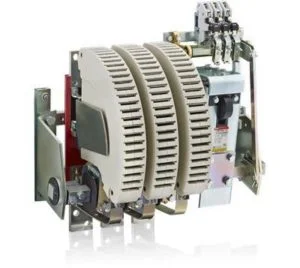
As mentioned earlier, DC arcs are more severe when compared to AC arcs. In DC contactors magnetic blowouts are used to propagate the arcs towards specially designed arc chutes and extinguish them by splitting them. In those contactors used in low voltage AC applications (690Volt or less), atmospheric air surrounding the contacts extinguishes the arc and in medium voltage and high voltage applications vacuum contactors are used to avoid the risk of arc.
Categorization
A few important IEC utilization categories are below:
Contactors are categorized based on the type of load (IEC utilization categories – IEC 60947) and current and power rating (NEMA size).
- AC-1: Non-inductive or slightly inductive and resistive heating type of loads
- AC-2: Starting of slip ring induction motor
- AC-3: Starting and switching off Squirrel-cage motors during the running time
- AC-15: Control of AC electromagnets.
- AC-56b:- Switching of capacitor banks
- DC–1: Non-inductive or slightly inductive and resistive heating type of loads
- DC-2: Starting, inching, and dynamic breaking of DC shunt motors
- DC-3: Starting, inching, and dynamic breaking of DC series motors
- DC-13: Control of DC electromagnets
NEMA sizing
NEMA size is based on the maximum continuous current and horsepower rating of the induction motor controlled by the contactor. Under NEMA standards contactors are designated as size 00,0,1,2,3,4,5,6,7,8,9.
Application of contactors
Motor Starters:
Motor contactors are used in Direct-on-line or Star Delta starters along with thermal overload relays or motor protection circuit breakers. Even in our homes, one can find it inside the pump starters. Normally in a motor starter circuit, they are used for switching, along with overload relay and short circuit protection devices.
Switching of capacitor Banks
In capacitor banks, capacitor switching contactors are used to switch capacitors based on the reactive power requirements. They are specially designed to control high transient currents formed during switching. Additional resistors are provided to reduce inrush currents while switching.
Lighting control
Contactors are also used in the switching of street, commercial and residential lights. They are commonly used in timer-controlled lighting systems. Latch-type contactors are also available. In this type, two coils will be present, one of them for opening the contacts and the other for closing. The closing coil closes the contacts, when excited and cuts off the supply to the coil. Contact is then held closed mechanically. The second coil is used for opening the contacts.
Read more: DOL starter sizing and Selection of contactor and overload relay for DOL starter
How to check a contactor?
A contactor can be checked whether it is “open” or “closed” using an ohmmeter or a multimeter. If the resistance measured between the input and output terminals is infinite then the contacts are opened and if the ohmmeter reading is zero then it is denoted that the contacts are closed.
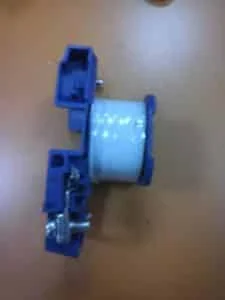
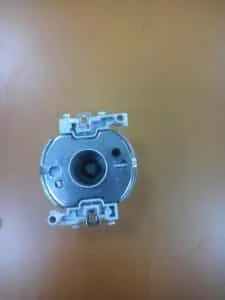
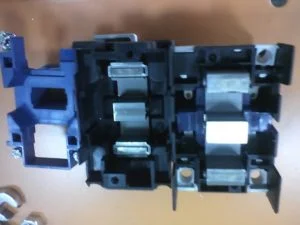
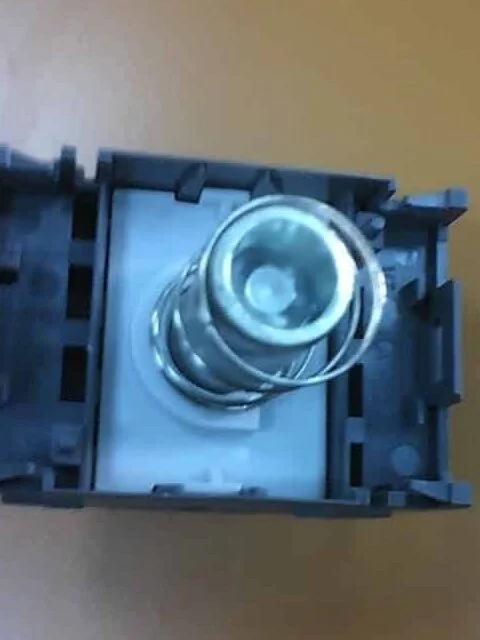
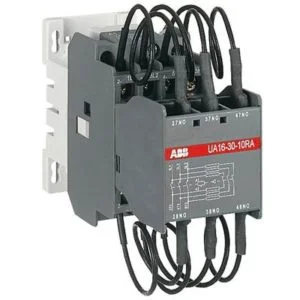
how to select contractor for 15 hp motot and also selct star and delta contractor
Good lessons continue
Very nice information
How to select contactor to operate pneumatic solenoid valve?
you can select relay sir!!!
Very informative blog. Thanks for sharing such kind of relevant information about contactors.
when it is de-energized because of an overload happening. In circuits with higher loads, the contactors’ connections are welded together. This can cause a dangerous situation because if there is an overload, the circuit will not open.
In residential central split AC systems, contactor is a component of the outdoor compressor assembly. Indoor thermostat opens and or closes the contactor during normal operation of the AC system.
contactors in electrical: An electrical contactor is a switch that opens and closes an electrical circuit. It’s a type of relay, but is designed for higher current applications.